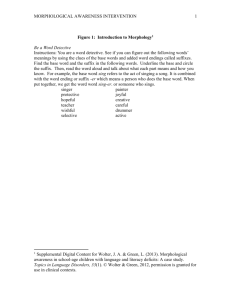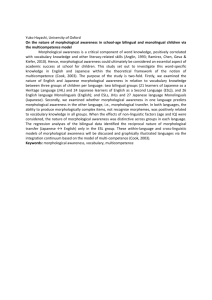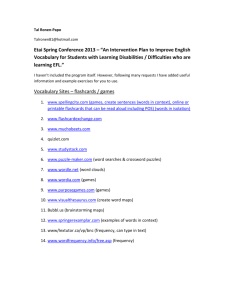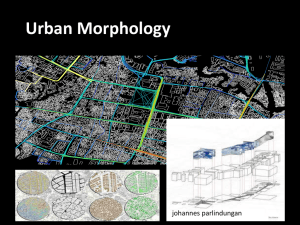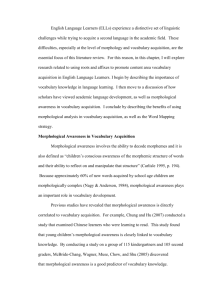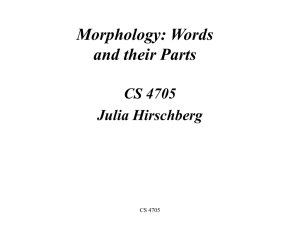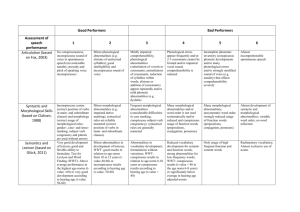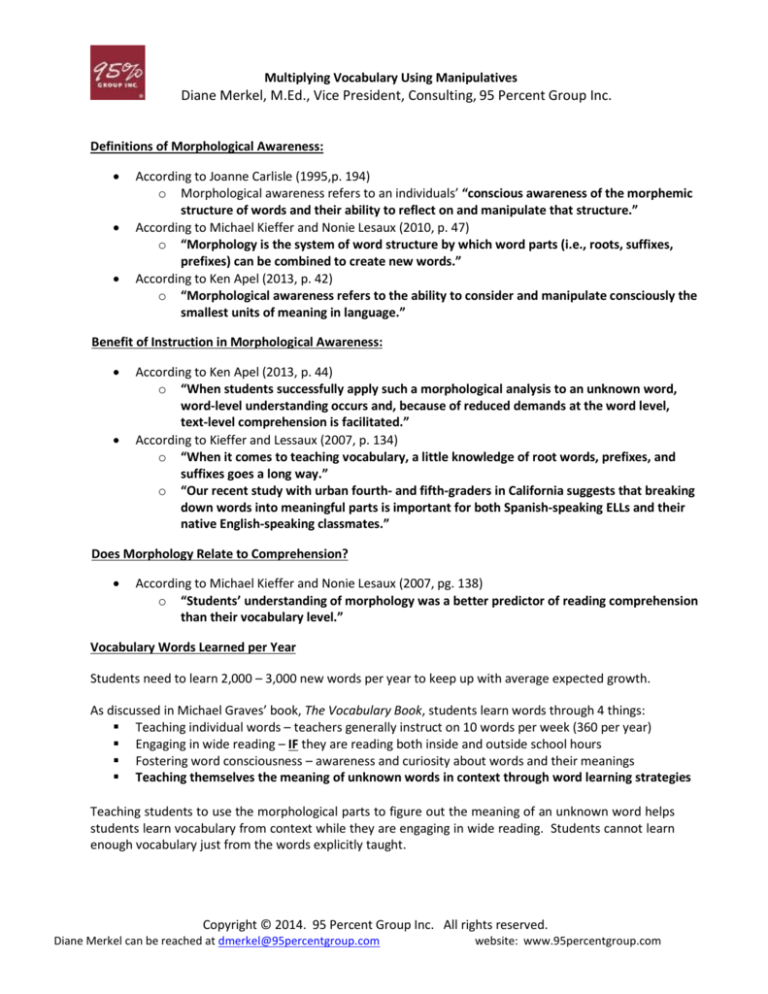
Multiplying Vocabulary Using Manipulatives
Diane Merkel, M.Ed., Vice President, Consulting, 95 Percent Group Inc.
Definitions of Morphological Awareness:
According to Joanne Carlisle (1995,p. 194)
o Morphological awareness refers to an individuals’ “conscious awareness of the morphemic
structure of words and their ability to reflect on and manipulate that structure.”
According to Michael Kieffer and Nonie Lesaux (2010, p. 47)
o “Morphology is the system of word structure by which word parts (i.e., roots, suffixes,
prefixes) can be combined to create new words.”
According to Ken Apel (2013, p. 42)
o “Morphological awareness refers to the ability to consider and manipulate consciously the
smallest units of meaning in language.”
Benefit of Instruction in Morphological Awareness:
According to Ken Apel (2013, p. 44)
o “When students successfully apply such a morphological analysis to an unknown word,
word-level understanding occurs and, because of reduced demands at the word level,
text-level comprehension is facilitated.”
According to Kieffer and Lessaux (2007, p. 134)
o “When it comes to teaching vocabulary, a little knowledge of root words, prefixes, and
suffixes goes a long way.”
o “Our recent study with urban fourth- and fifth-graders in California suggests that breaking
down words into meaningful parts is important for both Spanish-speaking ELLs and their
native English-speaking classmates.”
Does Morphology Relate to Comprehension?
According to Michael Kieffer and Nonie Lesaux (2007, pg. 138)
o “Students’ understanding of morphology was a better predictor of reading comprehension
than their vocabulary level.”
Vocabulary Words Learned per Year
Students need to learn 2,000 – 3,000 new words per year to keep up with average expected growth.
As discussed in Michael Graves’ book, The Vocabulary Book, students learn words through 4 things:
Teaching individual words – teachers generally instruct on 10 words per week (360 per year)
Engaging in wide reading – IF they are reading both inside and outside school hours
Fostering word consciousness – awareness and curiosity about words and their meanings
Teaching themselves the meaning of unknown words in context through word learning strategies
Teaching students to use the morphological parts to figure out the meaning of an unknown word helps
students learn vocabulary from context while they are engaging in wide reading. Students cannot learn
enough vocabulary just from the words explicitly taught.
Copyright © 2014. 95 Percent Group Inc. All rights reserved.
Diane Merkel can be reached at dmerkel@95percentgroup.com
website: www.95percentgroup.com
Multiplying Vocabulary Using Manipulatives
Diane Merkel, M.Ed., Vice President, Consulting, 95 Percent Group Inc.
Characteristics of Layers of Language (Excellent reference: Unlocking Literacy, by Marcia Henry)
Anglo-Saxon
10 – 20% of English words that we use about 65% of the time in our speaking and writing
Short, common, everyday words
Originate from a Germanic base
Most are single syllable
Spelling is often irregular
Contains silent letters, vowel teams, consonant blends, digraphs, r- and l- controlled vowels, etc.
Compound words with defined structure
Latin
50 - 55% of all English words
Most often polysyllabic
Meanings of Latin roots are often abstract
Often found in literature or social studies
Many roots are closed syllables
Does not use “k’ or “ck”
Use of “ct” or “pt” as final blends
Greek
11% of English words
Technical, specialized words, especially related to science and math
Begin to appear in textbooks around 3rd grade.
Greek morphemes combine or compound
Have no strict structure
Often use ch=/k/, ph=/f/ and y=both short and long i sound.
Steps in a Lesson (15 minutes per day): (lesson will be demonstrated in session)
Day 1: Uncover the Meaning – give students 2 sentences containing word part you’re teaching
Day 2: Deepening the Meaning – learn how changing affixes changes the word’s meaning
Day 3: Word Multiplier – use many word parts to build lots of new words – write meanings
Day 4: Demonstrate Meaning – use words in sentences showing understanding
Reference List:
Apel, K., Diehn, E., and Apel, Lynda. (2013). Using multiple measures of morphological awareness to assess its relation to
reading. Topics in Language Disorders, Vol. 33, No. 1, 42-56.
Chall, J., and Jacobs, V. (2003). Poor children’s fourth-grade slump. American Educator, Spring 2003.
Graves, M. (2006). The Vocabulary Book: Learning and Instruction. New York, NY: Teachers College, Columbia University.
nd
Henry, M. (2010). Unlocking Literacy: Effective Decoding & Spelling Instruction (2 edition). Baltimore: Brookes.
Kieffer, M., and Lesaux, N. (2007). Breaking down words to build meaning: Morphology, vocabulary, and reading
comprehension in the urban classroom. The Reading Teacher, 61 (5), 134-144.
Kieffer, M., and Lesaux, N. (2010). Morphing into adolescents: Active word learning for English-language and their
classmates in middle school. Journal of Adolescent & Adult Literacy, vol. 54 (1), 47-56.
nd
Moats, L. (2009). LETRS, Module 3, Spellography for Teachers: How English Spelling Works (2 edition) Longmont, CO:
Sopris West.
Tong, X, Deacon, S., Kirby, J, Cain, K, Parrila, R. (2011) Morphological awareness: A key to understanding poor reading
comprehension in English. Journal of Educational Psychology, 2011, Vol. 103, No. 3, 523-534.
Copyright © 2014. 95 Percent Group Inc. All rights reserved.
Diane Merkel can be reached at dmerkel@95percentgroup.com
website: www.95percentgroup.com


